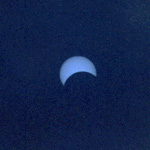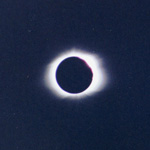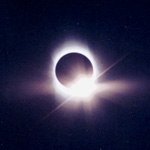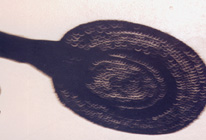|























| |
Total Solar Eclipse from Aruba
Brian Faltinson Reports Back from Vacation with
Images and Words
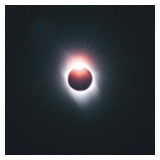 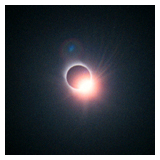 Aruba, February 26 1998
Aruba, February 26 1998
 Eclipse Sequence
Eclipse Sequence
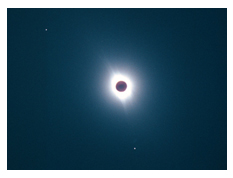 Eclipse Showing the Planets Mercury
(top left) and Jupiter (bottom centre)
Eclipse Showing the Planets Mercury
(top left) and Jupiter (bottom centre)

What better excuse for a vacation than to go to the Carribean
in winter to see a total solar eclipse. My wife MaryAnn and I
selected Aruba because it had the best probability of clear skies
according to the 1997 Observer's Handbook. Probability is no guarantee
as we were to find out.
The weather was exactly the same every day with 30 degree C
with light clouds over the central portion of the island. On eclipse
day scarey dark clouds weather came in on the trade winds two
hours before the beginning of the partial phase. We decided to
have faith and drive as planned to the southern most point of
the Island to maximize the duration of totality. Ra was good to
us by clearing the clouds completely just as partial phase began.
Apparently NASA and a few thousand other people/scientists
with mega equipment agreed with my analysis of the best dry land
site as well as the best point on the island. Totality was 3.5
minutes and was truly the most amazing thing I've seen (and felt)
in my life. Watching the shadow come and go also had some surprises
which made this a bizzare experience that words can't describe.
We are shadow chasers now.
I used Kodak Gold 400 ASA film to ensure the winds would not
blur my pictures. My 105mm telephoto did not compare with the
other equipment around us but it proved simple to set up and was
also useful for the rest of the vacation! I varied exposure times
from 1/10th sec to 1/2 sec on automatic exposure with little apparent
difference in the shots. The exposure meter setting was set for
averaging to allow for the less precise framing of the eclipse.
For the partial phase shots I held a No. 14 Welders glass filter
over the lens, this produced the characteristic green colour of
this filter. This would not have been my preference as I would
have liked to have used an appropriate Neutral Density filter
to avoid the green colouration. The No. 14 Welders glass was also
used for viewing the eclipse visually.
I will use 200 ASA next time and perhaps get a larger lens
for Europe in August, 1999. Mmm, German beer AND a solar eclipse!

Eclipse from Antigua
Experiencing a Total Solar Eclipse - Erika Pleasance
My husband, Ken, and I took a cruise offered by Astronomy Magazine
to view the total solar eclipse of February 26, 1998. We flew
to San Juan Puerto Rico on February 18th and spent two days exploring
the San Juan area. We joined the rest of the cruise group on February
20th, and visited the observatory at Humacao College, where local
island astronomers had their scopes set up for us for a star party.
Ken and I were two of the fortunate few to be invited into the
observatory to view CCD images.
On Saturday morning, February 21st, we boarded busses for a
trip to the Arecibo Observatory - the largest radar/radio telescope
on earth. It has a giant 305 meter diameter dish located on 28
acres of land in the mountains of northern Puerto Rico.
After our return to the hotel, busses took us to our ship,
the Galaxy. We boarded at 3:00 pm and sailed from the harbour
at 11:00. Sunday morning found us anchored off Catalina Island.
While many enjoyed a day in the sun on the lovely beaches of Catalina,
we boarded a catamaran which took us for a tour of part of the
Dominican Republic. After arriving back at the Galaxy, we set
sail at 5:00 pm and spent the following day at sea enroute to
Barbados. We toured much of the island and saw Harrison Caves,
returning to the ship at 4:00 pm and the next leg of the journey
to Martinique. We toured much of Martinique, partly by land (taxi)
and then by sea (catamaran), observing the Mt. Pelee volcano and
visiting St. Pierre, the city demolished by the volcano's explosion
in 1902. In the afternoon, we attended lectures by Rich Talcott
and Dave Eicher, editors of Astronomy magazine. The Galaxy steamed
off at 5:00 pm for Antigua, and the event we had been waiting
for.
The ship stopped at Antigua at 8:00 am, leaving those who wished
to stay on the island for the eclipse. Ken decided to stay on
the island and I decided to stay on board ship. The Galaxy positioned
itself on the centerline of the eclipse path, and sailed along
it as the event progressed. It was an event I will never forget.
As the sky darkened, Venus appeared just above the horizon. Once
we were in the cone of totality, Mercury and Jupiter were visible
outside the corona, and all around, the horizon had the appearance
of a sunrise or sunset. In a few minutes, it was all over, and
the sun started to reappear from behind the moon.
Ken, being on land, had the chance to see how animals reacted
to the eclipse, and was amused to see a herd of goats scurry off
in the direction of home as darkness descended. The Galaxy returned
to Antigua later that afternoon to pick up the shore bound passengers,
and then headed for St. Thomas. Again, we enjoyed a tour of the
island, and returned to the ship for the last leg of the journey
back to San Juan, arriving there on Saturday morning at 7:00 am.
We spent the day touring more of San Juan, then caught our plane
home on Sunday, March 1st, returning to reality
Photos: Ken Pleasance
A few images of the eclipse as it progressed through
its stages, partial, total and the diamond ring.
Photo: Erika Pleasance
A straw hat was held up over the ground projecting
numerous miniature eclipses. For a more detailed view of the image
click on the image.
|





